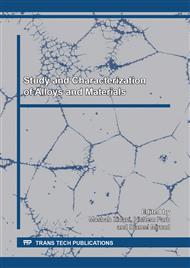p.76
p.81
p.88
p.101
p.111
p.118
p.125
p.141
p.147
Growth of ZnO Nanorods by Template-Free Sol-Gel Dip-Coating Technique: Effect of Pre-Annealing Temperature
Abstract:
In this work, we studied the effect of pre-heating temperature on the structural and optical properties of ZnO nanorods grown by free template sol-gel dip-coating technique. The prepared films were pre-heated at different temperatures: 240, 260, 280 and 300 °C, then annealed at 500 °C for one hour. The structural properties of the prepared samples were investigated by X-ray diffraction (XRD) and the surface morphologies were studied by scanning electron microscope (SEM). The optical properties were studied by means of UV-Visible spectrophotometer. The XRD diffraction spectra show that all the prepared samples have a ZnO wurtzite structure with a preferential orientation along (002) axis. SEM micrographs revealed the formation of well-aligned ZnO nanorods for the sample preheated at 280 °C. The prepared ZnO nanorod structured thin films are highly transparent in the visible region with an average transmittance above 85 % in the 400–800 nm wavelength range.
Info:
Periodical:
Pages:
111-117
Citation:
Online since:
September 2019
Keywords:
Price:
Сopyright:
© 2019 Trans Tech Publications Ltd. All Rights Reserved
Share:
Citation:


